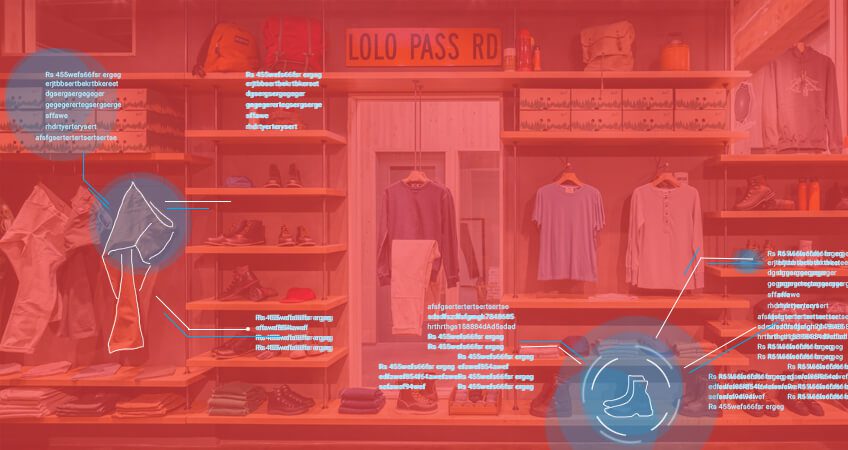Changing times are not bringing any easy moment for the brick and mortar retailers. Online retail businesses zoom along at double digits as the digital world consistently penetrates physical retail stores. Online shopping has transformed the way we shop while shaping up the success stories of brands. However, physical retail stores are not going to take the exit route anytime soon. In the interim, retail industry leaders are experimenting with digital retail stores by adopting various technological innovations to cope with the growing market needs – as with any industry in this era.

What’s Changing Retail?
Do you remember that website visitor who had a couple of items in her wishlist but didn’t purchase anything? She might have purchased the same item from your physical store without you even realizing it. In today’s digitally connected age, the internet has become a ‘must-have’ in the shopping process irrespective of whether the purchase is made online or in-store. Futuristic payment processing technologies, interconnected digital mediums, and OTT applications are making the consumer decision journey less linear and more fluidic.
Market-savvy consumers are leaving retailers perplexed. Consumer behavior underpins omnichannel retailing that aligns all channels including social media, e-commerce and physical stores. Brick and mortar retailers have started realizing that their physical existence is a minuscule part of the overall consumer experience.

A gargantuan opportunity awaits retailers, who are keen to integrate their digital platforms into their physical infrastructure in a manner that boosts loyalty, delights customers, and generates value. To put it simply, the need of the hour for businesses is to choose digitization as their customers have chosen to go digital. However, digital retail stores can meet customer expectations in a way that online-only platforms can only dream of.
Putting the Customer First – Beyond Digitization
Much has already been blogged and tweeted about consumer perception. However, the big question is – what motivates your consumers? The consumer mindset has changed since the emergence of the digital age.
Even though retailers have migrated to digital channels, it turned out to be a two-way trip. Today’s consumers want to surf multiple channels and gain a seamless buying experience.
Hence, progressive retailers integrate the advantages of physical stores with digital elements. This offers visual navigation and tactile experience to their consumers.
Synergizing digital and physical infrastructure can pave the way for significant growth in retail profits driven by:
- higher conversion rate
- inventory reduction
- thriving marketing outcome
With significant opportunities in an omnichannel approach well understood, retailers must focus on channels most preferred by consumers. Let us take a close look at these channels.
Social Media Channel to Personalize Customer Relationship
Given the rise of social media-savvy consumers, retailers must carve out a prominent presence on social networks, and provide customers a ‘wow’ experience. Since social media platforms such as Facebook, Twitter, and Periscope enable customers to directly interact with brands, they help retailers personalize their relationships with customers.
A Yesmail survey tracked the social media habits of 50 top retail brands across five major categories – beauty, apparel, electronics, big box and home goods. According to the survey, more than 90% of brands are using two or more social networks. 100% of the brands in the home goods category were using multiple channels. However, the apparel industry has a big social media presence. 86% used four channels and more than 60% represented on all the five social networks that were analyzed.

Making the Most of Mobile Apps
Retailers need to create a dedicated app for mobile users, who prefer using smartphones for their shopping needs. To attract users to purchase through their apps, retailers must provide exclusive app-only offers and loyalty programs. The focus of digital retail must also extend toward sending out promotional alerts via mobile apps, where users need to visit the store physically and avail those offers while making purchases. Retailers in order to enhance the online/app shopping experience, need to design simple apps with a user-friendly interface. This can be further shored up with live chat assistance, alternate suggestions, and product reviews on the app.

Augmented Reality is the Reality of Future Retail
Retailers are always looking to enrich the shopping journey of customers. Hence, they are integrating innovative digital experiences into their physical outlets with the presence of digitized kiosks, touch screen navigation panels, interactive digital displays and other digital tools to ensure an engaging in-store experience.
Apparel retailers are putting up digital catalogs that enable customers to browse through items and virtually try them on without physically looking for them in-store. Such innovations of retailers create a strong impact on customers and make their shopping experience unique. This attracts customers to regularly visit their stores, thanks to their technologically advanced approach.

Beacons Become Retail Mainstream
The use of beacons by US and Europe-based retailers such as Target and Macy’s is revolutionizing the customer retail experience. These beacons use Bluetooth low energy to track nearby customers and send them relevant messages/notifications on their smartphones via apps. These messages can range from a simple welcome message to suggestions based on their past shopping to recommendations of new products in-store or a discount coupon. The objective of this technology is to build a personal bond with the customer with an ultimate goal of driving traffic and sales. The use of beacons is basically an example of proximity marketing, which creates an engaging and dynamic in-store customer experience.

‘Supermarket of the Future’ is saving Consumer’s Time
The first ‘Supermarket of the Future’ by Coop – Italy’s largest supermarket chain – is another notable example of digital retail innovation. Powered by Microsoft Kinect and Azure, this supermarket opened its doors in December 2016 in Milan. Customers can see all necessary product information about a product such as its origins, nutritional facts, correlated products, and promotions. This seamless shopping experience is beneficial for shoppers as they can choose the right products, thus saving their time. This technology is also beneficial for Coop, as it helps them analyze data about products, which generate high sales so that they can stock items accordingly in their inventory. It also helps them with customer information and insights, which make it easier for them to understand their buying behavior.
Omnichannel Data under One Roof – Digital Retail Store
Your customers are not standing still – and neither is the evolution in your industry. The ‘next gen’ customer wants to be enticed and engaged with the seamless buying experience. Indeed, time is ripe for retailers to figure out ways to deliver integrated pricing standards, unified customer view, better product visibility, and flexible buying options – across all channels.
Access to consumer data is an invaluable advantage for digital retailers. By analyzing data from all sources, retailers can better connect an exploding range of products down to an exceedingly relevant experience for consumers.
Those days will be over when retailers said with pride, “I have more products for sale than anyone else.” Today’s consumers don’t want to waste time on billions of items. The happiest consumer is the one who says, “I was looking for this, and nothing else.” Today’s consumers want retailers to know them. Hence, data from multiple channels under one roof is key to attaining success in the digital retail space.
It is still early days. However, digital retailers are striving to set examples by delivering an inspiring and utilitarian shopping experience to their consumers. And who knows? The next time you drive past a retail store, an exciting offer by the retailer might just pop up on your connected car display.









